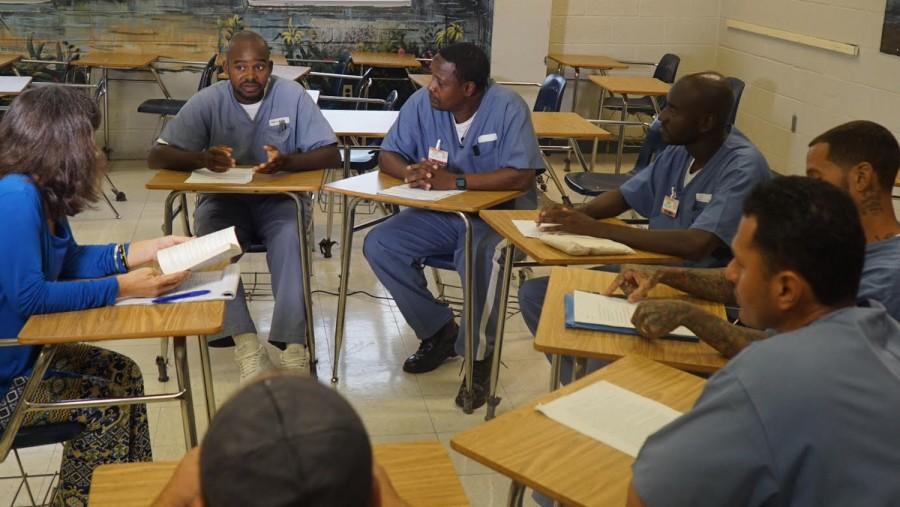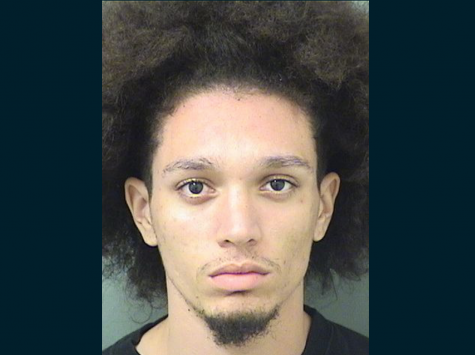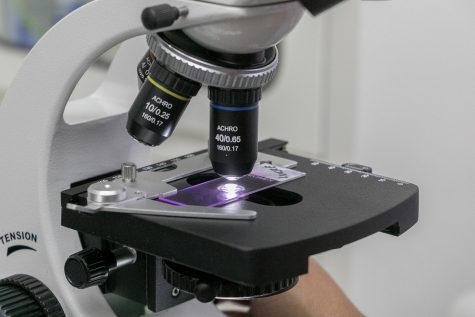FAU Students Exchange Writings with Local Correctional Institution
In Wendy Hinshaw’s rhetorics of incarceration class, students exchange their writing with incarcerated writers of Dade Correctional Institution.
Kathie Klarreich (right), creator and chair of Exchange for Change, with an inmate at the Dade Correctional Institution. Photos courtesy of Victor Rivera and Carlos Sterling with In & Out Productions.
February 3, 2016
For students who were looking for unusual pen pal ideas this spring, all they had to do was add “rhetorics of incarceration” to their schedules.
Rhetorics of Incarceration is a special topics course in the English department, taught by Wendy Hinshaw. This class is a part of Exchange for Change, a non-profit organization where students anonymously exchange their writing works with imprisoned persons taking a writing course at the Dade Correctional Institution of Miami-Dade County.
Students from both academic and correctional institutions will collaborate and share feedback on a series of essays, based on the students’ identities as writers as well as ongoing conversations about assigned readings. Each assignment, the students are randomly given a new partner from their sister institution.
The first exchange is an essay titled “Why I Write,” an assignment where students of both institutions discuss their goals, writing methods and what influences them as a writer. The following week, students will randomly exchange their essay with someone from the other institution.
During the trade, students read each other’s work and provide their response to it in addition to feedback on writing and development. Often, these exchanges lead to a discovery of common ground between the two anonymous writers, such as similar backgrounds or motivations.
Once the response is made, it is sent back to the original author and they get a final opportunity to reply.
In the past, this course was a major success. “It was really transformative for everybody involved,” Hinshaw said. “There were a lot of these moments where people connected on things they wouldn’t have anticipated.”
Anonymity
This isn’t the sort of pen pal where you sign your name at the bottom. A key factor in the Exchange for Change program is the anonymity between both incarcerated persons, the inside writers — and academic students, the outside writers. Both use fake names and never communicate directly. Instead of face-to-face exchanges, Hinshaw travels between the two institutions and does the physical exchange. Everything brought into the prisons needs to be approved and checked, even the assigned readings.
“[This method] enables the writing to be the focus, a level of anonymity, and a level of privacy that really helps us get at the power differences and the assumptions we have about the writers that we’re exchanging with,” Hinshaw said.
She also noted the preconceived notions her previous graduate school classes had: “They assumed that they would have the upper hand … and they thought of themselves as lending their expertise, lending their talents and had thought of it as kind of a service,” she said.
“[The students] realized really quickly that the writers we were responding with, some of them had advanced degrees, many of them were really talented writers themselves. So it broke down a lot of stereotypes and barriers right off the bat.”
Keeping both classes anonymous has little to do with safety concerns. According to Hinshaw, there has never been a safety concern, incident or an occurence of feeling unsafe.
In the past, inside and outside students got to meet on the prison writing program’s graduation day. “At the end of the class you get a graduation, you get a certificate,” she said. “It was a really terrific moment of the students meeting each other.”
At the graduation, the women at the inside institution were asked if they wanted to continue using their pseudonyms, but they all chose to have their full names visible.
“After leaving [the graduation], one of my FAU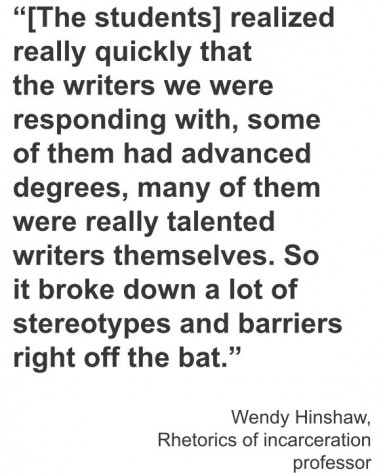 students came to me and talked to me. There had been a writer he really connected with — everyone had connected with somebody — so, he found out her legal name, he looked her up and was really shocked by the crime,” Hinshaw said. While the woman had nothing to do with the student or his family, he had experienced a crime similar to hers that had affected his family and life deeply.
students came to me and talked to me. There had been a writer he really connected with — everyone had connected with somebody — so, he found out her legal name, he looked her up and was really shocked by the crime,” Hinshaw said. While the woman had nothing to do with the student or his family, he had experienced a crime similar to hers that had affected his family and life deeply.
Hinshaw said that the situation proved why anonymity worked.
“Once he knew, he came to me and talked about it, and he was really wrestling with it, it really changed how he thought about her, he really regretted knowing, and so that moment of watching that whole process unfold and come full circle really made me think about and appreciate the model that Kathie and I had built. If he had known her name and known her crime going into it, his experience in the exchange would have been entirely different … It’s kind of a gift to connect with people in this way.”
How It Began
The organization started when Hinshaw and Kathie Klarreich — creator and chair of Exchange for Change — branched off from ArtSpring, a similar organization that focuses on using the arts to strengthen communities.
They decided to make the transition because even though ArtSpring’s main mission was about the arts overall and investing in the women at Homestead Correctional Institution in Dade County, Hinshaw and Klarreich wanted to focus on getting a message out there.
“We want to bring those benefits [of writing and creation] in, we want to bring those resources in where they otherwise don’t exist. We also want to get voices out, get creative and critical expressions that are coming from these men and women.”
One of the biggest struggles for an organization like Exchange for Change revolves around funding. “It’s not easy to get many [funds] for the arts, it’s not easy to get money for education, and it’s certainly not easy to get many for prison programs,” Hinshaw said.
“It’s because we have this idea that if you’re in prison, you deserve nothing … We have this idea that prisoners are getting more than they deserve, and whatever they have they probably shouldn’t because once you’ve done something wrong you deserve to have everything taken from you. So it’s hard to counteract that.”
Success Stories
Within the Exchange for Change program, Hinshaw and Klarreich had many memorable moments. “I have a million success stories,” Klarreich said.
She once had a student come into class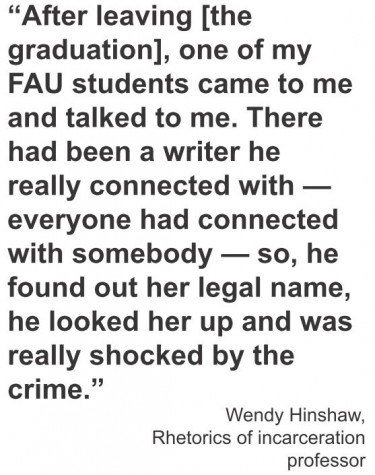 who
who
barely wrote more than a few paragraphs. Now, that student writes 10-page stories and is slated to be a mentor for other incarcerated writers in future classes.
Each time Klarreich starts a new class, she asks someone to be a mentor to come in and help, like a teaching assistant. “It just opened up a floodgate for him to be able to express himself,” she said.
The Exchange for Change program also resulted in a number of deep connections between writers. One involved a high school student and an incarcerated female writer: “He had an older sister who had run off to college, and he only learned after she went up to college that she was gay and she’d never told him because he had been very careless in his language and slurs on homosexuals in general and she didn’t feel safe telling him. He was really distraught when he found out that he’d been such a jerk and had been writing about how now he was learning to understand himself,” Klarreich said.
“The person that he had partnered up on the inside was a woman who has known that she’s gay for probably most of her life, and she had a very tumultuous relationship with her brother, and he ended up getting HIV through needles — not through sex but through needles — and dying, and how profound that experience was for her trying to repair her relationship,” she continued. “[It] was difficult because of the brother’s homophobia and her ability to share that experience with this guy on the outside, saying ‘You’re so lucky, you have the rest of your life to share this relationship with your sister.’”
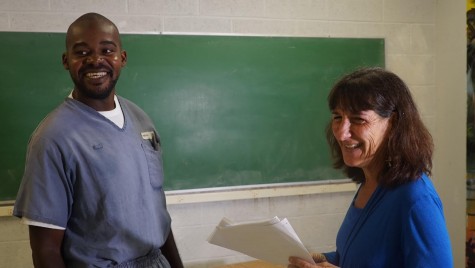
The Future of Exchange for Change
The Rhetorics of incarceration class is offered every few semesters, previously to graduate students but more recently to undergraduates. Each time the class is taught, Hinshaw and Klarreich think of ways to improve the course and change things up. In the prisons, writers take the class multiple times so they may continue their education, but that may also lead to topics if there is no change.
“It’s always a balance of trying new things that are gonna be interesting and valuable for the inside students and that are also going to meet the needs and interests of the outside students, the university students that may be entirely new to this,” Hinshaw said.
This spring semester, Hinshaw plans to end the class with an audio collection, featuring works from both inside and outside students. “That’s really new for Exchange for Change, that’s new for the inside students and that’s new for probably many outside students as well.”
This audio collection may be out of reach to incarcerated persons because of their limited Internet access. “Even though they are cut off, many of them have a surprising knowledge and level of access to Internet, which is totally contraband, but they have their own ways for having viewed the Exchange for Change website, and being to-date with things, another one of the reasons why we are more careful with anonymity and privacy,” noted Hinshaw.
They will not be accessing the audio collection website as per the no-internet rule, but will have a good idea of what the site will look like through the facilitator — the course instructor inside the institution.
“One of our main goals is for people to be aware. To think about the criminal justice system differently and to recognize that they’re people too, they are people who have made mistakes — oftentimes very costly mistakes,” Klarreich said. “We’re working with people who want to change … We’re trying to offer an opportunity for people who do want to make a difference.”
Student Involvement
When asked about advice for students interested in the program, Klarreich encouraged people to attend events. “When the opportunity presents itself, come to a graduation or a performance inside the institution. I guarantee it will be life-changing. Everybody who’s come inside has walked out with a totally different perception of the world, about criminal justice and prison reform.”
The graduations allow incarcerated writers to read their work. “You’ll see the depth and the breadth and the talent because they are individuals just like the rest of us. Some are funny, some are poignant, some are sad. They are individuals.”
Hinshaw plans to continue teaching the rhetorics for incarceration class in the future. The earliest that the class can return to FAU would be spring 2017, but it may move to the following year.
If you are interested in learning more about or donating to Exchange for Change, you can visit its website at exchange-for-change.org.
Brittany Ferrendi is a staff writer for the University Press, and is currently enrolled in Wendy Hinshaw’s Rhetorics of Incarceration class.

